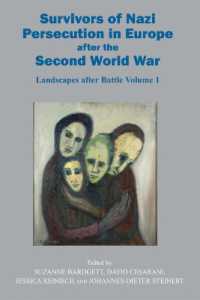- ホーム
- > 洋書
- > 英文書
- > History / World
Full Description
What do Turkey and India have in common? Burcu Çevik-Compiègne brings sources from two apparently separate contexts into conversation to offer fresh insights into the Great War and its ongoing legacy, highlighting the perspectives of people in two post-imperial nation states. She uses public discourses, literature, oral histories, memorials and other material as entry points into histories of writing, overwriting and erasing the shadows of an imperial war. The connections and parallels between Turkey and India are traced in the narratives of self and the nation from the war to the present and across the globe, all the way to contemporary Australia.
Contents
Acknowledgements
List of Figures
Introduction
Part 1: Ideas
1 Emergence of Pan-Islamism
1 Civilisational Discourse
2 Ottoman Governance of Diversity
3 Pan-Islamism in Diplomacy
4 Indian Muslim Solidarity with the Young Turks
5 Indian Red Crescent Mission
6 Pan-Islamism in Retrospect
7 Politics of Pan-Islamism
8 Ottomans in India
2 Entering the War
1 Turco-German Alliance
2 Ottoman-German Jihad
3 The Indian Home Front
3 Global Jihad and the Anticolonial Movement
1 Political Agitation across Borders
2 Mutineers, Revolutionary Fighters and Half-Hearted Jihadis
3 'Turkish War after the War', the Khilafat and Non-cooperation
Part 2: Experiences
4 Pre-national Armies
1 Recruitment
2 Motivations for Enlistment and Fighting
3 Desertion and Disloyalty
4 Fighting for the Homeland?
5 Officers
6 Changing Political Views during the War
5 Feeling the War
1 Soldiers' Letters
2 Treating Trauma
3 Venereal Disease and Race
4 Privation and Shortages
6 Intercultural Encounters
1 Indian and Turkish Soldiers' Encounters
2 Accommodating Religious Needs
3 Oriental Women and 'Unpatriotic Effeminates' in PoW Camps
4 Intimacy and Affection
5 Language and Communication
6 Arrival in Europe
7 Romance and Sexual Encounters
8 Towards Cosmopolitanism?
9 Savages and Saviours
10 Oriental Mates
11 Maleficent Captors
7 Women and War: "How Different Are the Ideas Suggested by the Above Two Words!"
1 "An Army of Mothers and Sisters" and Labourers
2 Resistance and Political Activism
3 Women: from an Element of Backwardness to the Symbol of Modernity
Part 3: Remembering
8 Writing the War
1 Sources in Fiction
2 War as Part of Larger Narratives
9 Postcolonial Sites of Memory
1 Memorialisation of the Dead
2 The Anzac Estate: "One Big Graveyard"
3 Earlier Turkish Responses to Memorials and Cemeteries in Gallipoli
4 Contesting the 'National Park'
5 Un-writing the Imperial and Pre-national Past
10 From Empire to Multiculturalism: Anzac Day
1 Early Responses of South Asians in Australia to the War
2 Transnational Politics of Anzac Day
3 Military Identity
4 Multicultural Politics of Remembrance
5 Islam and Multiculturalism
Conclusion
Bibliography
Index







